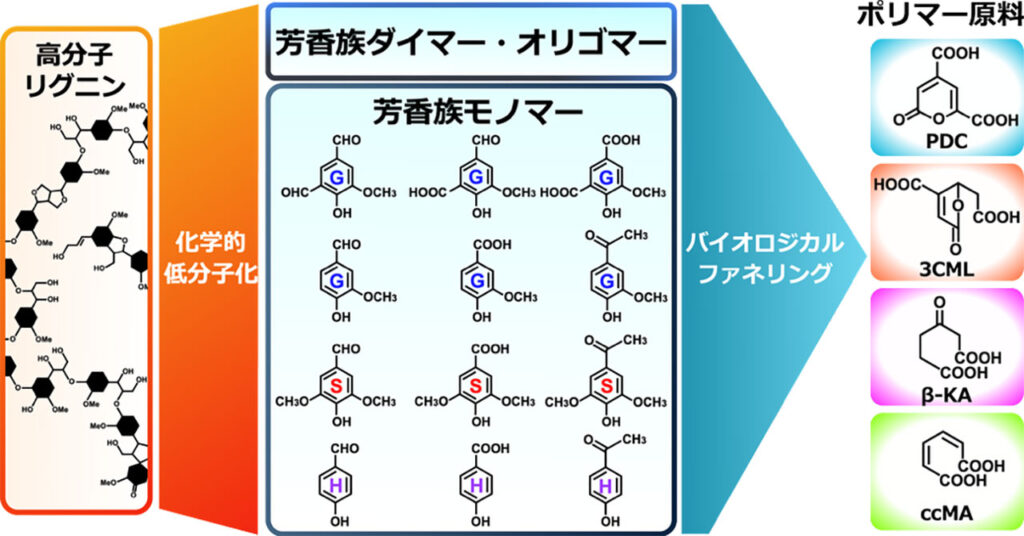Research into utilizing microbial metabolism is gaining momentum to establish lignin utilization technology, a key to realizing a carbon-free society
Updated by Eiji Masai on August 04, 2025, 6:35 PM JST
Eiji MASAI
Nagaoka University of Technology
Professor, Faculty of Engineering, Nagaoka University of Technology. His specialty is applied microbiology, and he is working on elucidating the microbial metabolic systems of lignin-derived aromatic compounds. Based on the knowledge obtained, he is working on the development of microbial strains that contribute to the production of valuable products from lignin.
Reducing dependence on petroleum and securing sustainable material raw materials are essential to realize a decarbonized society. To address this challenge, lignin, which constitutes 9-32% of plant cell walls, has attracted significant attention. Approximately 20 billion tons of lignin is produced annually, of which unused waste lignin from pulp and paper mills alone is estimated to amount to about 100 million tons per year. Lignin, this abundant aromatic polymer, is expected to be a powerful alternative raw material for plastics, which are produced at an annual rate of about 400 million tons. However, due to the complexity of its structure, it is not easy to establish a method for utilizing lignin, and many technological developments are still in progress. The establishment of lignin utilization technology is an important key to provide a new material raw material to replace petroleum and accelerate the transition to a decarbonized society.
In recent years, the development of systems to produce specific valuable products from lignin by chemically reducing its complex macromolecular structure to a low molecular weight and combining it with the metabolic capabilities of microorganisms has been actively pursued in the United States and elsewhere as a means of effectively utilizing lignin. Dr. Greg Beckham and his colleagues at the U.S. Renewable Energy Laboratory have initiated what they call "biological funneling," a technology for converging and converting the miscellaneous aromatic compounds produced by lignin degradation into valuable products such as polymer materials by utilizing the metabolic capabilities of microorganisms.
Potential microbial intermediate metabolites as polymer feedstock include the metabolite protocatechuic acid (PCA), which is formed from vanillin via vanillic acid from the oxidative degradation of lignin. In bacteria, PCA is metabolized via aromatic ring cleavage at either the 2,3-, 3,4-, or 4,5-position. Among these, the following dicarboxylic acids are of interest as polymer raw materials.
2-Pyrone-4,6-dicarboxylic acid (PDC), an intermediate metabolite of the 4,5-cleavage pathway
β-keto-adipic acid (β-KA), an intermediate metabolite of the 3,4-cleavage pathway
3-Carboxymuconolactone (3CML), an intermediate metabolite of the 3,4-cleavage pathway in fungi
Cis,cis-muconic acid (ccMA), an intermediate metabolite of catechol produced by the decarboxylation of PCA

The concept of "biological funneling" was born out of research on PDC production from lignin-derived aromatic compounds and the development of PDC polymers in Japan. 2000-, Professor Yoshihiro Katayama of Tokyo University of Agriculture and Technology, the Forestry and Forest Products Research Institute, and Nagaoka University of Technology have promoted joint research. Currently, using a metabolically modified strain of Pseudomonas putida, PDC production of about 100 g/L has been achieved in the fermentation production of vanillic acid as a raw material.
The development of PDC polymers was also carried out in parallel, and Professor Atsutaka Shigehara's group at Tokyo University of Agriculture and Technology led this research. PDC is a quasi-aromatic compound with two carboxy groups substituted on the pyrone ring. Polyester and other polymers can be generated by polycondensation of its 4,6-position carboxy groups with bifunctional monomers. If terephthalic acid in polyethylene terephthalate (PET) is replaced by PDC, a biomass-derived polyester can be obtained. Furthermore, hot-pressing can be used to produce solvent-insoluble high-molecular-weight films.
Currently, Professor Takeshi Michinobu of Tokyo University of Science, a research participant since that time, continues to develop PDC polymers. Recent studies have reported that PDC polyesters exhibit strong adhesion to wood and are safe and environmentally friendly bio-based adhesives that are biodegradable.
Detailed knowledge of the metabolic system of lignin-derived aromatic compounds in bacteria is essential to establish a system for producing valuable products from lignin through "biological funneling. Our group has been studying the metabolic system of lignin-derived aromatic compounds in Sphingobium lignivorans strain SYK-6 for more than 30 years.
Strain SYK-6 is a Gram-negative bacterium isolated from a kraft pulp effluent treatment tank at a paper mill. This strain has the ability to utilize G-, S-, and H-type lignin-derived monomers, as well as dimeric compounds with various intermolecular bonds, as growth sources. About 80 genes involved in the metabolism of these compounds and their functions have been identified, and the metabolic system of this strain is positioned as a model for the metabolism of lignin-derived aromatic compounds by bacteria. We are currently developing a valuable substance-producing strain based on this strain in order to develop a substance-producing system that makes use of the extremely wide range of lignin-degrading products metabolizing ability of SYK-6 strain. (Eiji Masai, Professor, Faculty of Engineering, Nagaoka University of Technology)